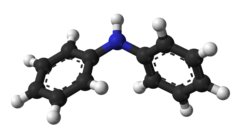
| |

| |
| Names | |
|---|---|
| Preferred IUPAC name
N-Phenylaniline[1] | |
| Other names
(Diphenyl)amine
Diphenylamine (deprecated[1]) Diphenylazane N-Phenylbenzenamine Anilinobenzene (Phenylamino)benzene N,N-Diphenylamine C.I. 10355 Phenylbenzenamine | |
| Identifiers | |
3D model (JSmol)
|
|
| Abbreviations | DPA |
| 508755 | |
| ChEBI | |
| ChEMBL | |
| ChemSpider | |
| ECHA InfoCard | 100.004.128 |
| EC Number |
|
| 67833 | |
| KEGG | |
PubChem CID
|
|
| RTECS number |
|
| UNII | |
| UN number | 2811 3077 |
CompTox Dashboard (EPA)
|
|
| |
| |
| Properties | |
| C12H11N | |
| Molar mass | 169.23 g/mol |
| Appearance | White, off-white[2] |
| Odor | Floral[3] |
| Density | 1.2 g/cm3 |
| Melting point | 53 °C (127 °F; 326 K) |
| Boiling point | 302 °C (576 °F; 575 K) |
| 0.03%[3] | |
| Vapor pressure | 1 mmHg (108°C)[3] |
| Acidity (pKa) | 0.79[4] |
| -109.7·10−6 cm3/mol | |
| Hazards | |
| Occupational safety and health (OHS/OSH): | |
Main hazards
|
Toxic. Possible mutagen. Possible teratogen. Harmful in contact with skin, and if swallowed or inhaled. Irritant. |
| GHS labelling: | |
   
| |
| Danger | |
| H301, H311, H319, H331, H373, H410 | |
| P260, P261, P264, P270, P271, P273, P280, P301+P310, P302+P352, P304+P340, P305+P351+P338, P311, P312, P314, P321, P322, P330, P337+P313, P361, P363, P391, P403+P233, P405, P501 | |
| NFPA 704 (fire diamond) | |
| Flash point | 152 °C (306 °F; 425 K) |
| NIOSH (US health exposure limits): | |
PEL (Permissible)
|
none[3] |
REL (Recommended)
|
TWA 10 mg/m3[3] |
IDLH (Immediate danger)
|
N.D.[3] |
| Related compounds | |
Related Amine
|
Aniline |
| Supplementary data page | |
| Diphenylamine (data page) | |
Except where otherwise noted, data are given for materials in their standard state (at 25 °C [77 °F], 100 kPa).
| |
Diphenylamine is an organic compound with the formula (C6H5)2NH. The compound is a derivative of aniline, consisting of an amine bound to two phenyl groups. The compound is a colorless solid, but commercial samples are often yellow due to oxidized impurities.[5] Diphenylamine dissolves well in many common organic solvents, and is moderately soluble in water.[6] It is used mainly for its antioxidant properties. Diphenylamine is widely used as an industrial antioxidant, dye mordant and reagent and is also employed in agriculture as a fungicide and antihelmintic.[7]
- ^ a b International Union of Pure and Applied Chemistry (2014). Nomenclature of Organic Chemistry: IUPAC Recommendations and Preferred Names 2013. The Royal Society of Chemistry. p. 671. doi:10.1039/9781849733069. ISBN 978-0-85404-182-4.
- ^ https://www.sigmaaldrich.com/Graphics/COfAInfo/SigmaSAPQM/SPEC/24/242586/242586-BULK_______SIAL_____.pdf [bare URL PDF]
- ^ a b c d e f NIOSH Pocket Guide to Chemical Hazards. "#0240". National Institute for Occupational Safety and Health (NIOSH).
- ^ "Diphenylamine".
- ^ P. F. Vogt, J. J. Gerulis, "Amines, Aromatic" in Ullmann’s Encyclopedia of Industrial Chemistry 2005, Wiley-VCH, Weinheim. doi:10.1002/14356007.a02_037
- ^ "Conclusion on the peer review of the pesticide risk assessment of the active substance diphenylamine". EFSA Journal. 10: 2486. 25 January 2012. doi:10.2903/j.efsa.2012.2486.
- ^ Safe, S.; Hutzinger, O.; Crocker, J. F. S.; Digout, S. C. (1977). "Identification of toxic impurities in commercial Diphenylamine". Bulletin of Environmental Contamination and Toxicology. 17 (2): 204–207. Bibcode:1977BuECT..17..204S. doi:10.1007/BF01685551. PMID 843636.
